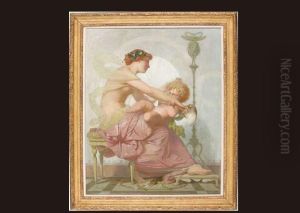Jacques Vict. Eugene Froment-Delormel Paintings
Jacques Victor Eugène Froment-Delormel, born in 1820 and deceased in 1876, was a French artist known primarily for his work as a painter. He was part of the artistic movements in France during the 19th century, a period that was rich in transformation and innovation in the arts. However, Froment-Delormel is not one of the most widely recognized artists of his time, and as a result, detailed information about his life and work is not as abundant as that of his contemporaries like Eugène Delacroix or Jean-Auguste-Dominique Ingres.
Froment-Delormel’s work was created during a time when France was undergoing significant changes, both politically and culturally. The country was shifting from the Romanticism of the early 19th century to the Realism and Impressionism that would dominate the latter half of the century. Artists of the period were exploring new approaches to art, focusing on everyday life, nature, and light. While it is not clear to which extent Froment-Delormel was influenced by these movements, it can be assumed that the artistic environment of the time played a role in his development as an artist.
Unfortunately, specific details about Froment-Delormel’s training, his major works, and his influence on the art world are not well-documented. It is likely that he received traditional artistic training, which would have included studying the masters of the past and rigorous practice in drawing and painting techniques. His style would have been shaped by the predominant tastes of the day, and possibly by the academic standards set by the French Academy, which dictated artistic success during much of the 19th century.
What can be said about artists like Froment-Delormel is that they contributed to the rich tapestry of French art during a time of great change. Even if individual artists did not achieve fame, they were part of the collective effort that pushed the boundaries of art and paved the way for future generations. Froment-Delormel’s death in 1876 marked the end of a life spent in the pursuit of artistic expression during one of the most vibrant periods of art history.
In the absence of more specific information about Froment-Delormel’s oeuvre, art historians often rely on broader art historical context to understand the work and life of less-documented artists. As such, while Froment-Delormel may not have the same level of fame as some of his peers, his life and work remain a part of the complex narrative of 19th-century French art. It is within this narrative that his contributions, whatever their nature or impact, should be acknowledged and appreciated.


